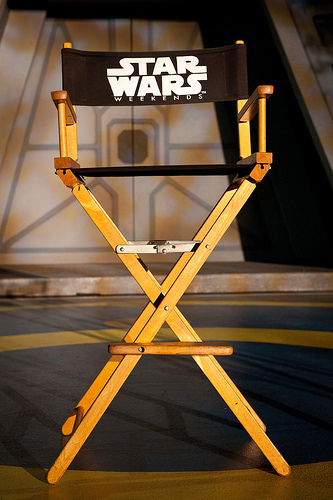Read the following text called How are Hollywood films made? and fill in the gaps using the words below:
| script |
lighting |
shots |
shoot |
| fade |
feature |
frame |
editor |
| conveying |
droves |
scenery |
scene |
| crew |
studio |
performers |
foundation |
| schedule |
lines |
rehearse |
rehearsal |
| budgets |
role |
alias |
goal |
Looking through the lens of a camera as actors bring to life a writer's story, the filmmaker is also peering into a world of imagination. The director, producer, actors, screenwriter, and film editor are all essential players in the journey from concept to finished film. In this remarkable process, thousands of small details—and often hundreds of people—come together to create a Hollywood film.
With the advent of sound for film in the 1920s actors needed something to say. Writers flocked to Hollywood in droves from Broadway and from the worlds of literature and journalism. For a brief time in the 1930s, some of the world's most famous writers wrote Hollywood scripts: William Faulkner, F. Scott Fitzgerald, Bertolt Brecht, and Thomas Mann.
The director's vision shapes the look and feel of a film. He or she is the creative force that pulls a film together, responsible for turning the words of a script into images on the screen. Actors, cinematographers, writers, and editors orbit around the director like planets around the Sun. Despite the director's pivotal role, most Hollywood movies are designed to pull you into the story without being aware of the director's hand. Many talented film directors with long lists of feature film credits are so skilled at being "invisible" that they are little known by the movie-going public. Imagine you're being considered to direct a Hollywood film. You're handed a screenplay that has been "greenlighted" (given approval for production) by a major studio . As you read through it, you begin to imagine how it might play out on screen. You see the characters coming to life. You envision the lighting and hear the sound. You are absorbed in the world of the story until you see the script's final words:fade out. If you are hired as the director of this film, you may need to help shape the script for the screen. A good script is the foundation for a good film, but even the best one may need to be developed or molded to work well on the big screen.
The people you work with, both the actors and the crew who will make things work behind the scenes, are crucial to the film's success.
The film's producer acts as an administrator, communicator, and guide, helping hundreds of people reach a final goal :completing the film on schedule , on budget, and as the director envisioned. The producer administers all the various aspects of film production, from initial concept to script and budget preparation to shooting, post-production, and release.
A production designer is responsible for the believability of a film's scenery and sets. In essence, the production designer is the architect of the film, working to make your vision, as director, a reality. The production designer also works closely with the art director and set decorator, making certain all the visual details are accurate and the style and period of the film reflect your wishes.
The cinematographer, or director of photography, helps to translate your vision to film, scene by scene, planning shots and supervising camera operators. Often, cinematographers are artists with experience in painting and photography. Their job is to create and capture the images that best tell the story.
The actors you choose will bring your story to life. Your casting decisions will be based on such factors as availability and whether or not an actor is suitable for lead or ensemble acting. Actors are essential for conveying emotions to an audience, for bringing the words and ideas in a script to life. Even animated characters rely on the personalities of behind-the-scenes performers . As an actor, you study the role in depth. In order to learn your lines , you know you must learn the part. Memorizing lines without understanding the role will be of little help to you. You ask an actor friend to help you rehearse your lines, and after much study, you feel confident that you have done as much preparation as you can. You're ready to shoot the scene.
After months or even years of development, delays, and rewrites, the final script is set and the film goes into pre-production. During this phase, budgets are detailed, scenes are planned and designed, and a shooting schedule is prepared. Storyboards—visual representations of every shot—are prepared by a storyboard artist in consultation with the director, director of photography, and designer. Before a single frame is shot, the film is planned from beginning to end on paper. The final stages of pre-production include weeks of rehearsal , set construction, and location scouting. Once the shoot is over, hundreds of thousands of feet of film need to be assembled into a coherent story. Days or weeks of shooting result in only a few minutes of screen time.
Occasionally, a director dislikes the final cut and decides not to be listed in the credits. If this happens, the credits list Alan Smithee as the director. Alan Smithee is not a real person, but an alias used as a substitute when a director refuses to be linked to a film.

